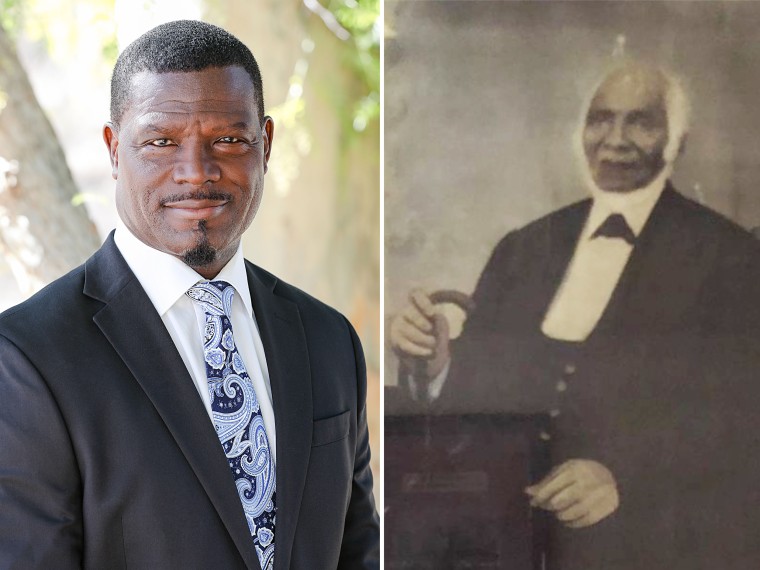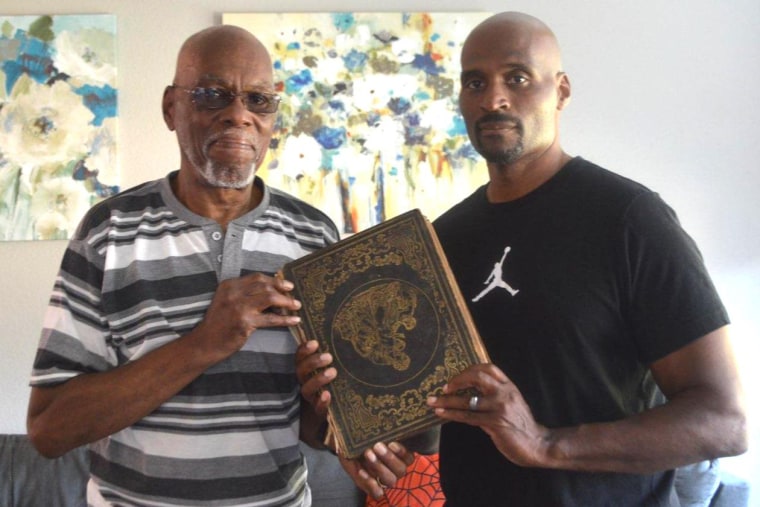The Blue family, Sacramento
Les Robinson had to leave a family cookout to compose himself. A cousin told him to look up an ancestor on his phone — Daniel Blue. Robinson had never heard of him, but a search revealed the longtime pastor in the Sacramento area, who was integral to the region’s Black community. Robinson learned that his great-great-grandfather was brought to Sacramento in 1849 as an enslaved man from Kentucky by John Daugherty, the son of his enslaver.
Blue, 53 at the time, worked as a gold miner and discovered enough gold to buy his freedom and become an entrepreneur, opening a dry cleaners and starting a church in his home and later a stand-alone structure. That church — St. Andrews AME Church — was founded in 1850, and it remains the West Coast’s oldest continuous African Methodist Episcopal congregation. Blue also started a school for Black, Latino, Asian American and Native American children.
And he bought property. Lots of it — 60 acres, according to Robinson, including nine blocks in Sacramento, California’s capital, documents show.
On that property today, Robinson said, stands the California Railroad Museum, the Amtrak Station, Sacramento RailYard, the courthouse and the Sacramento County jail.
But the question looms: “What happened to the property? We don’t know,” Robinson said. He said his research told a familiar, unnerving story — that the property was taken.

“I’ve been told that it was taken because the railroad needed that land to complete the transcontinental connection,” Robinson said. “So he basically was booted out.”
And burned out, as intimidation by whites who did not welcome freed Blacks turned violent. Part of the school was burned down and rebuilt before eventually it closed years later. Blue’s house was burned in 1869. There was a failed attempt to burn down the church, too, Robinson said.
Mitchell said the seizing of property — by citizens, law enforcement or the government — comes with an additional injustice beyond stunting generational wealth: It destroys culture and history.
“Whether you’re talking about Harlem or southwest Georgia, there’s often an erasure of important culture and history,” Mitchell said.
Much of what Robinson and others in his family have discovered is documented in newspaper articles and other periodicals, which makes it frustrating for Robinson that he cannot locate deeds or ownership documentation. They have not yet presented their findings to state or local officials yet, preferring to do more research and hear what the reparations task force has to say about seized land. But they are clear about what happened.
“It was obviously taken,” Robinson said. “He was a smart man. He wouldn’t give away 60-plus acres of land.” Robinson is working on a book about his ancestor that sums up what having the land returned to him and his family would mean. Yes, he wants the land for its financial value, but also for its sentimental value. Robinson, who founded a church in 1999, said the revelations about his ancestor resonate in a tangible way. Looking back and seeing what his ancestor accomplished, “I see parallels in our life — even not having ever known him,” he said. “When I found him, I met him — and we have the same spirit. I am doing what he would want me to do.”
The Burgess family, Coloma, California
It was “exhausting” for Jon Burgess when he learned that an ancestor had been the hangman in the 1800s in Coloma, a small community about 55 miles northeast of Sacramento, where his family lineage traces.
“That’s not something you want to see, and it floored me for two days,” Burgess said.
It was the price of digging into his family’s history. Burgess and twin brother Matthew have been floored for the last five years for another reason: In the family Bible, where many Black families used to document significant moments of family members’ lives, Burgess discovered that his great-great-great grandfather Rufus Burgess was one of the state’s first gold miners and that he built wealth and bought land in California at the end of slavery intent on its staying in the family for future generations.

Using eminent domain, the city seized much of the 420 acres, Burgess said. Much of the land he wants to reclaim is Marshall Gold Discovery State Historic Park in Coloma.
Burgess has testified before the California reparations task force, posted short videos on Instagram about his family findings to educate followers and connected with Gov. Gavin Newsom about the subject. “I’m just trying to get people to empathize with the fact that we had an inheritance that was supposed to remain in our family for years per those deeds. And yet it was stripped away,” he said.
Burgess possesses the deed to the land, documentation he believes that when it is properly reviewed will stand up in court, particularly because there is no record of his ancestor’s selling the land, he said.
“If we didn’t have the deed, it would just be another story,” said Burgess, a firefighter. “But we do. And the deeds can certainly tell a very different story.”
What’s next for reparations
The story for all these families is unfinished. They hope their gathered documentation will yield a result similar to that of Bruce’s Beach in Southern California, where Los Angeles County seized land in Manhattan Beach purchased in 1912 by a Black couple, Charles and Willa Bruce. White residents led a petition to have their resort for Black people condemned in 1927 and turned into a park. It was returned to the Bruce family last year. The family sold it back to the county for $20 million.
The cases are not parallel to that of Bruce’s Beach, but it elicits hope for these descendants, especially as California considers reparations in such an aggressive manner.
Burgess’ case has been acknowledged by the California task force as similarly valid to that of Bruce’s Beach, and may be included in its final report and list of recommendations, which will be issued to the Legislature at the end of June.
“Land and property are things that my pioneer ancestors did not sell or take for granted, because they knew the value, coming from slave plantations’ making others wealthy for generations — all behind land,” Burgess said. “Generational wealth means my family and descendants would have the same if not more than the Bogle family, Veercamp family, Gallagher family, Del Monte family and a host of others who came here with nothing prior to 1870 and were left to prosper — but also allowed equal protection by the laws.”






